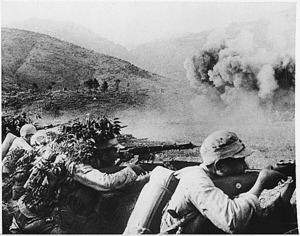Start date 1944 Result Chinese victory | End date September 7, 1944 | |
 | ||
7,763 casualties including 4,000 killed 1,290 killed7 captured Similar Second Sino‑Japanese War, Battle of Yenangyaung, Siege of Myitkyina, The Hump, Battle of Kunlun Pass | ||
The battle of mount song
The Battle of Mount Song (松山战役, in Japanese: "The Battle of Ramou" (拉孟の戦い)) in 1944 was part of a larger campaign in southwestern China during the Second World War. Chinese Nationalist forces aimed to retake the Burma Road. The Japanese Army in Southern Yunnan was at risk of being cut off from advancing British and American troops in Northern Burma. The Japanese Army aimed to block the highway for as long as possible. Constructing a series of tunnels and bunkers over a static two-year period they turned the mountain and its immediate environs into a fortress. Songshan (in Chinese) Matsuyama (in Japanese) blocked the road immediately behind the Salween River. Although the Chinese Nationalist Army crossed the river with light casualties and surrounded the Japanese garrison, they found that their offensive capability was limited because of this garrison behind their line of advance.
Contents
- The battle of mount song
- The battle of mount song that turned the tide of war in yunnan
- Fall and Aftermath
- Comfort Station
- Significance
- References
The Chinese forces were unaware of the depth of the Japanese defences, and their underestimation led to heavy casualties through a slow and cautious campaign. Chinese artillery strikes and US bombing runs had little effect against Japanese forces underground. Japan also set up a series of hidden pillboxes to ambush the Chinese forces.
After three months of battle, the Chinese forces finally retook Mount Song through the use of extended bombardment and an overabundance of US aid and training, as well as several tons of U.S. TNT placed in tunnels beneath the fortifications. Once open the Burma Road could be used to supply China with aid via a land route.
The battle of mount song that turned the tide of war in yunnan
Fall and Aftermath
The Japanese listed only one survivor, Captain Kinoshita, an artillery officer and one other soldier ordered out to communicate to the Japanese high command the night before the fall of the outpost, with apparently one other soldier. Chinese sources say 7 soldiers were captured out of the total garrison, Japanese sources do not mention prisoners.
Comfort Station
Upon the exortations of Senior Staff Officer Masanobu Tsuji, a comfort station was established in early 1944. About 12 Japanese comfort women committed suicide towards the end of the siege after fighting alongside the Japanese garrison. Another five or six Korean comfort women were captured by Chinese and US forces. These were eventually repatriated.
Significance
After the capture of the stronghold, the Burma Road could be used once again to supply China.
Although defeated, the small Japanese force, unsupplied and lacking air power or heavy artillery, held up the entire Chinese Expeditionary Army for over three months considerably lengthening the war in Burma.
From the Chinese side though it represented an important event, being the first place retaken by Chinese forces during the Second Sino-Japanese War. The Chinese government built a memorial park on top of the mountain with 402 sculptures representing soldiers from the Chinese Expeditionary Army spread over an area of 190000 sq. feet.
